高中英语 二轮专题复习 句法2-名词性从句 课件
文档属性
| 名称 | 高中英语 二轮专题复习 句法2-名词性从句 课件 | 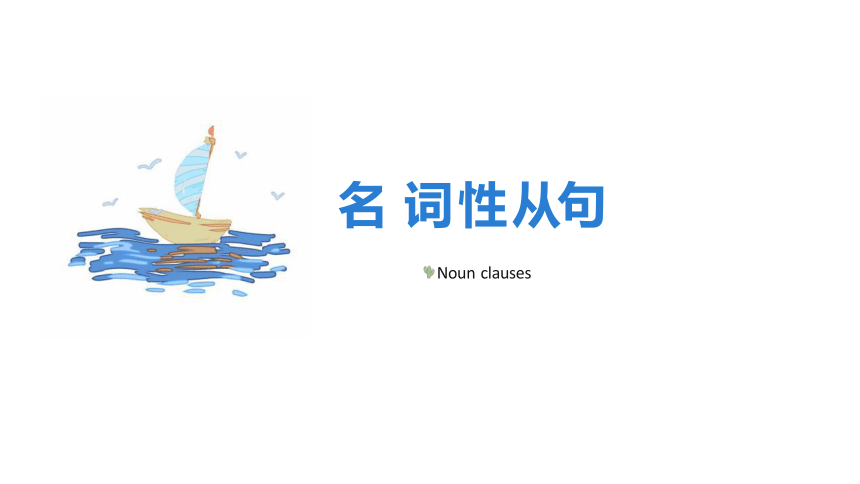 | |
| 格式 | pptx | ||
| 文件大小 | 151.6KB | ||
| 资源类型 | 试卷 | ||
| 版本资源 | 人教版(2019) | ||
| 科目 | 英语 | ||
| 更新时间 | 2025-02-27 08:44:35 | ||
图片预览

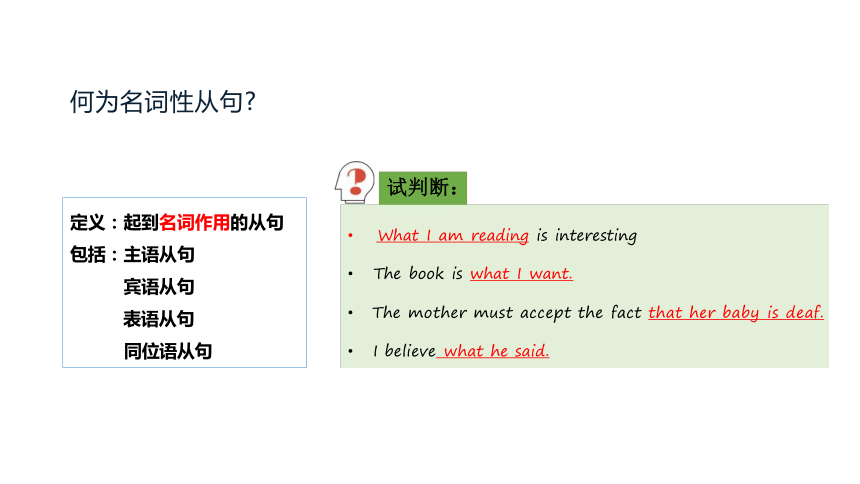
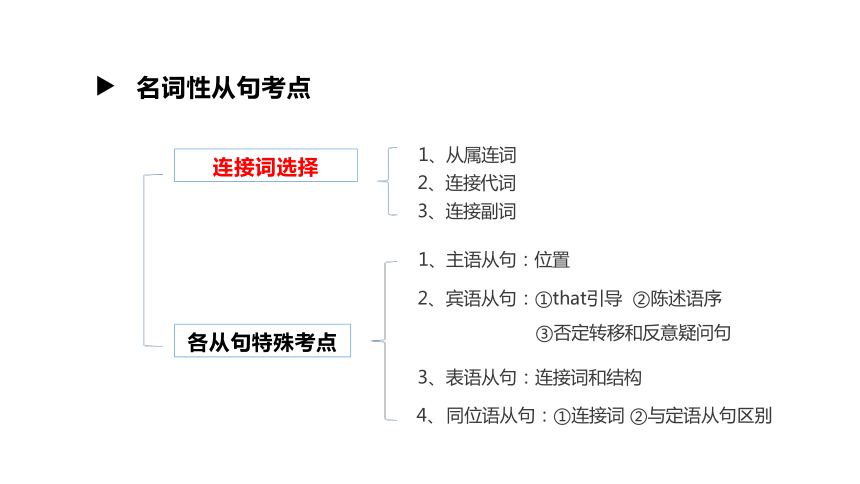
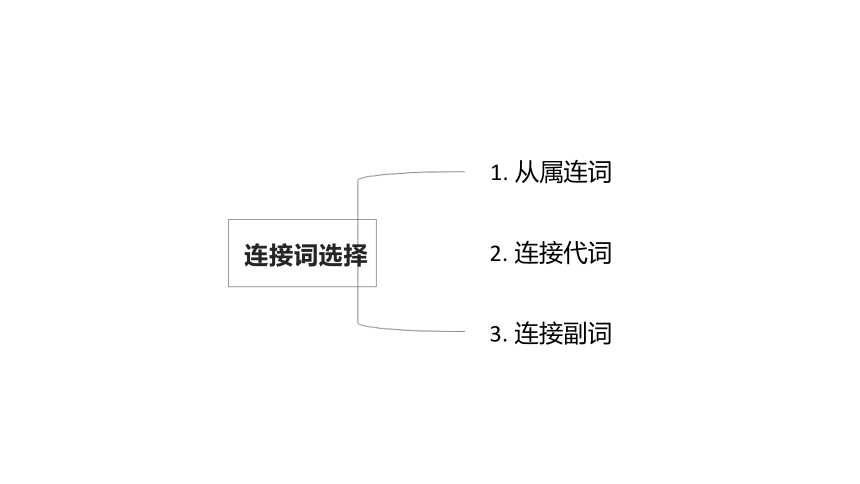
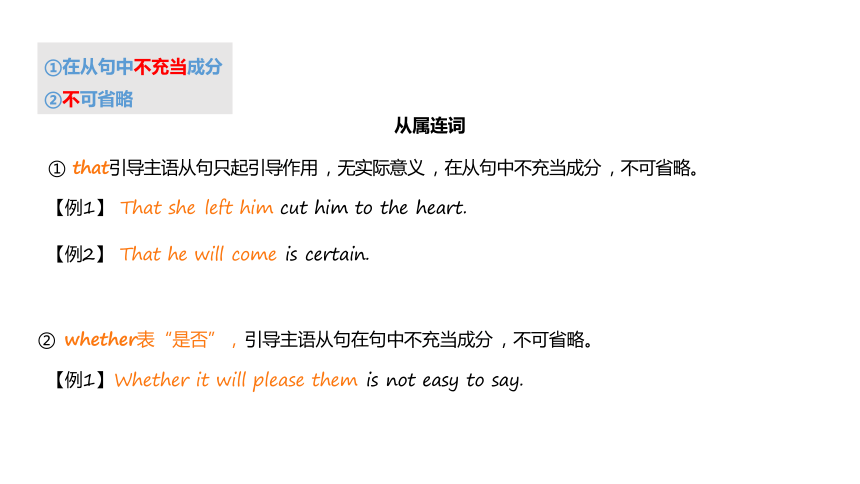
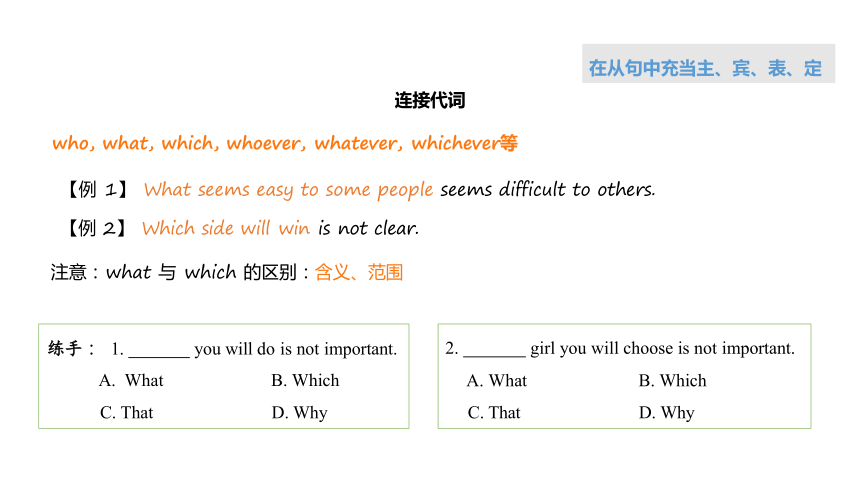
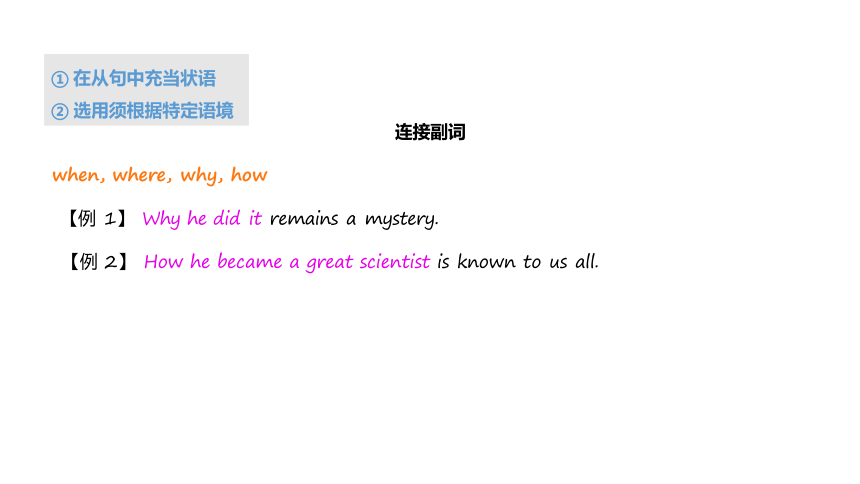
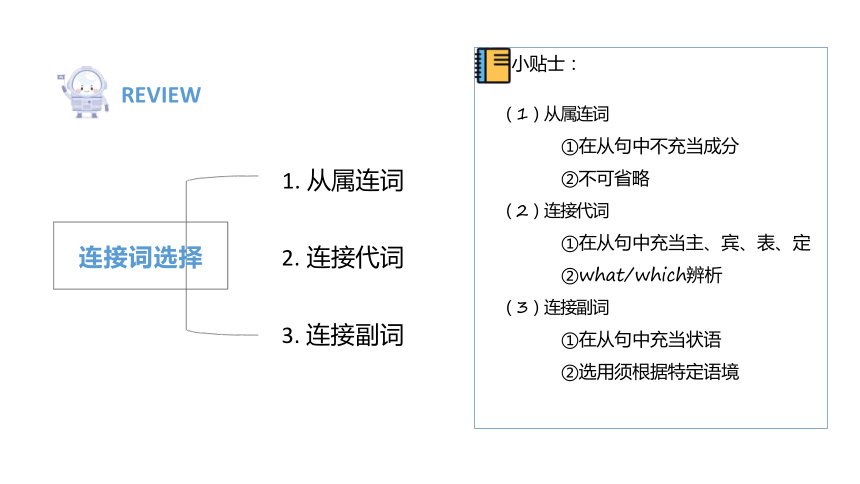
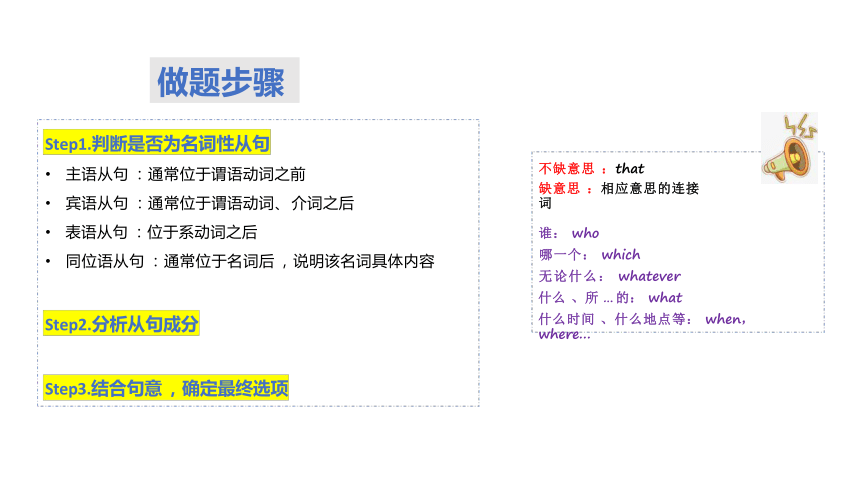
文档简介
(共27张PPT)
名 词 性 从句
Noun clauses
试判断:
What I am reading is interesting
The book is what I want.
The mother must accept the fact that her baby is deaf.
I believe what he said.
何为名词性从句
定义:起到名词作用的从句
包括:主语从句
宾语从句
表语从句
同位语从句
1、从属连词
2、连接代词
3、连接副词
1、主语从句:位置
2、宾语从句:①that引导 ②陈述语序
③否定转移和反意疑问句
3、表语从句:连接词和结构
4、 同位语从句:①连接词 ②与定语从句区别
连接词选择
各从句特殊考点
名词性从句考点
1. 从属连词
2. 连接代词
3. 连接副词
连接词选择
① that引导主语从句只起引导作用 ,无实际意义 ,在从句中不充当成分 ,不可省略。
【例1】 That she left him cut him to the heart.
【例2】 That he will come is certain.
② whether表“是否”, 引导主语从句在句中不充当成分 ,不可省略。 【例1】 Whether it will please them is not easy to say.
①在从句中不充当成分
②不可省略
从属连词
连接代词
who, what, which, whoever, whatever, whichever等
【例 1】 What seems easy to some people seems difficult to others. 【例 2】 Which side will win is not clear.
注意: what 与 which 的区别:含义、范围
2. girl you will choose is not important.
A. What B. Which
C. That D. Why
练手: 1. you will do is not important.
A. What B. Which
C. That D. Why
在从句中充当主、宾、表、定
① 在从句中充当状语 ② 选用须根据特定语境
连接副词
when, where, why, how
【例 1】 Why he did it remains a mystery.
【例 2】 How he became a great scientist is known to us all.
小贴士:
(1)从属连词
①在从句中不充当成分
②不可省略
(2)连接代词
①在从句中充当主、宾、表、定
②what/which辨析
(3)连接副词
①在从句中充当状语
②选用须根据特定语境
连接词选择
1. 从属连词
2. 连接代词
3. 连接副词
REVIEW
Step1.判断是否为名词性从句
主语从句 :通常位于谓语动词之前
宾语从句 :通常位于谓语动词、 介词之后
表语从句 :位于系动词之后
同位语从句 :通常位于名词后 ,说明该名词具体内容
Step2.分析从句成分
Step3.结合句意 ,确定最终选项
谁: who
哪一个: which
无论什么: whatever
什么 、所 … 的: what
什么时间 、什么地点等: when, where...
做题步骤
不缺意思 :that
缺意思 :相应意思的连接词
1、 主语从句: 位置
2、 宾语从句:( 1) that引导
(2) 陈述语序
(3) 否定转移和反意疑问句
3、 表语从句: 连接词和结构
4、 同位语从句:( 1)连接词
(2) 与定语从句区别
特殊考点
他有两个女朋友是可耻的。
is shameful.
1. 主语从句
主语从句位置:
他有两个女朋友是可耻的。
That he has two girlfriends is shameful.
1. 主语从句
主语从句位置:
主语从句位置:
他有两个女朋友是可耻的。
That he has two girlfriends is shameful. It is shameful that he has two girlfriends.
1. 主语从句
主语从句位置: It + 系表/谓宾 + 主语从句
It +be+表语+主语从句
【例】 It is still uncertain whether he is coming or not.
It +不及物动词+主语从句
【例】 It doesn’t matter whether he will come or not.
It +及物动词(被动语态)+主语从句
【例】 It has been decided that the exhibition will not open on Sundays.
1. 主语从句
1、 主语从句 :位置
2、 宾语从句:( 1) that引导
(2) 陈述句语序
(3) 否定转移和反意疑问句
3、 表语从句: 连接词和结构
4、 同位语从句:( 1)连接词
(2) 与定语从句区别
特殊考点
She told me that she would accept my invitation .
I think that it will clear up this afternoon and that they will come to say goodbye to us .
句子结构 例句
②主语+ 及物动词+ 间接宾语+that宾语从句
(二) 宾语从句
1. 由连接词that引导的宾语从句
判断:that是否可省
③主语+ 及物动词+ 并列that宾语从句
James said that he was feeling better.
①主语+ 及物动词+that宾语从句
句子结构
例句
④ 主语+及物动词+to sb.+that从句
He explained to us that he had failed to catch the first bus.
⑤ it 作形式宾语时 ,that引导的宾语 从句
We felt it strange that she should leave without saying goodbye.
⑥主语 + 系动词 + 形容词 + that 宾语 从句
I am afraid that I’ve made a mistake.
(二) 宾语从句
1. 由连接词that引导的宾语从句
2. 宾语从句的陈述句语序: 连接词+主语+谓语+其他成分
【例1】 I don’t know what they are looking for.
【例2】 None of us knows where these new parts can be bought.
若主句主语是第一人称
谓语动词为think, consider, suppose, believe, expect, guess, imagine等 其后的宾语从句含有否定意义
一般要把否定词转移到主句谓语上 ,从句谓语用肯定式
I think this dress doesn't fit you well. ( ×)
I don’t think this dress fits you well. ( √ )
She thinks this dress doesn’t fit you well.
第一人称有想法 , 宾从否定要转移
3. 宾语从句中的否定转移和反意疑问
① 否定转移:
条件2
条件1
条件3
② 反意疑问:前肯后否 ,前否后肯 He is right, isn’t he
You don’t like her, do you
主句的主语为第一人称:在变成反意疑问句时 ,反意疑问句的主谓要与从句一致 I expect our English teacher will be back in this weekend, won’t he/she?
主句的主语为第二或第三人称:在变成反意疑问句时 ,反意疑问句的主谓与主句一致
She thought that film was not interesting, didn't she
You think I can't get up, don't you
第一人称有想法 ,反意疑问就从句
3. 宾语从句中的否定转移和反意疑问
1、 主语从句 :位置
2、 宾语从句:( 1) that引导
(2) 陈述句语序
(3) 否定转移和反意疑问句
3、表语从句: 连接词和结构
4、 同位语从句:( 1)连接词
(2) 与定语从句区别
特殊考点
(三)表语从句
连接词及结构:
① 一般结构:主语+系动词+表语从句
常见接表语从句的系动词有 be, look, remain, seem 等 The trouble is that he has lost his money.
② 连接词:as if/as though、 because
It looked as if it was going to snow.
The reason is that…
【例】 The reason why he is late is that he missed the early bus.
That is because…
【例】That's because we never thought of it.
That’s why…
【例】 That's why he got angry with me.
2. 其他常见结构
1、 主语从句 :位置
2、 宾语从句:( 1) that引导
(2) 陈述句语序
(3) 否定转移和反意疑问句
3、 表语从句: 连接词和结构
4、 同位语从句:( 1)连接词
(2) 与定语从句区别
特殊考点
I've come from Mr. Wang with a message that he won’t be able to see you this afternoon.
3. 连接词:that和whether常见( if, which不能引导同位语从句)
注意:有时同位语从句可以不紧跟在说明的名词后面 ,而被别的词隔开 ,如:
Several years later, word came that Napoleon himself was coming to inspect them.
news, idea, fact, promise, question, doubt, thought, hope, message, suggestion, word(消息), possibility...
1. 一般跟在某些名词后面 ,用以说明该名词表示的具体内容
2 . 常 见 的 可 以 跟 同 位 语 从 句 的 词 (抽 象 名 词 )
(四) 同位语从句
(四) 同位语从句
4. 同位语从句和定语从句的区别
① 与前面名词的关系
同位语从句:与前面的名词是同位关系, 说明、解释它前面名词的内容
定语从句:与前面的名词是修饰与被修饰关系, 限定前面名词范围
The news that I have passed the exam is true.
The news that he told me just now is true.
4. 同位语从句和定语从句的区别
② that 在从句中的作用
同位语从句:that是连词 ,在从句中不充当任何成分
定语从句:that是关系代词 ,在从句中充当主语、宾语或表语。
The idea that computers can recognize human voices surprises many people. The idea that he gave surprises many people.
名 词 性 从句
Noun clauses
试判断:
What I am reading is interesting
The book is what I want.
The mother must accept the fact that her baby is deaf.
I believe what he said.
何为名词性从句
定义:起到名词作用的从句
包括:主语从句
宾语从句
表语从句
同位语从句
1、从属连词
2、连接代词
3、连接副词
1、主语从句:位置
2、宾语从句:①that引导 ②陈述语序
③否定转移和反意疑问句
3、表语从句:连接词和结构
4、 同位语从句:①连接词 ②与定语从句区别
连接词选择
各从句特殊考点
名词性从句考点
1. 从属连词
2. 连接代词
3. 连接副词
连接词选择
① that引导主语从句只起引导作用 ,无实际意义 ,在从句中不充当成分 ,不可省略。
【例1】 That she left him cut him to the heart.
【例2】 That he will come is certain.
② whether表“是否”, 引导主语从句在句中不充当成分 ,不可省略。 【例1】 Whether it will please them is not easy to say.
①在从句中不充当成分
②不可省略
从属连词
连接代词
who, what, which, whoever, whatever, whichever等
【例 1】 What seems easy to some people seems difficult to others. 【例 2】 Which side will win is not clear.
注意: what 与 which 的区别:含义、范围
2. girl you will choose is not important.
A. What B. Which
C. That D. Why
练手: 1. you will do is not important.
A. What B. Which
C. That D. Why
在从句中充当主、宾、表、定
① 在从句中充当状语 ② 选用须根据特定语境
连接副词
when, where, why, how
【例 1】 Why he did it remains a mystery.
【例 2】 How he became a great scientist is known to us all.
小贴士:
(1)从属连词
①在从句中不充当成分
②不可省略
(2)连接代词
①在从句中充当主、宾、表、定
②what/which辨析
(3)连接副词
①在从句中充当状语
②选用须根据特定语境
连接词选择
1. 从属连词
2. 连接代词
3. 连接副词
REVIEW
Step1.判断是否为名词性从句
主语从句 :通常位于谓语动词之前
宾语从句 :通常位于谓语动词、 介词之后
表语从句 :位于系动词之后
同位语从句 :通常位于名词后 ,说明该名词具体内容
Step2.分析从句成分
Step3.结合句意 ,确定最终选项
谁: who
哪一个: which
无论什么: whatever
什么 、所 … 的: what
什么时间 、什么地点等: when, where...
做题步骤
不缺意思 :that
缺意思 :相应意思的连接词
1、 主语从句: 位置
2、 宾语从句:( 1) that引导
(2) 陈述语序
(3) 否定转移和反意疑问句
3、 表语从句: 连接词和结构
4、 同位语从句:( 1)连接词
(2) 与定语从句区别
特殊考点
他有两个女朋友是可耻的。
is shameful.
1. 主语从句
主语从句位置:
他有两个女朋友是可耻的。
That he has two girlfriends is shameful.
1. 主语从句
主语从句位置:
主语从句位置:
他有两个女朋友是可耻的。
That he has two girlfriends is shameful. It is shameful that he has two girlfriends.
1. 主语从句
主语从句位置: It + 系表/谓宾 + 主语从句
It +be+表语+主语从句
【例】 It is still uncertain whether he is coming or not.
It +不及物动词+主语从句
【例】 It doesn’t matter whether he will come or not.
It +及物动词(被动语态)+主语从句
【例】 It has been decided that the exhibition will not open on Sundays.
1. 主语从句
1、 主语从句 :位置
2、 宾语从句:( 1) that引导
(2) 陈述句语序
(3) 否定转移和反意疑问句
3、 表语从句: 连接词和结构
4、 同位语从句:( 1)连接词
(2) 与定语从句区别
特殊考点
She told me that she would accept my invitation .
I think that it will clear up this afternoon and that they will come to say goodbye to us .
句子结构 例句
②主语+ 及物动词+ 间接宾语+that宾语从句
(二) 宾语从句
1. 由连接词that引导的宾语从句
判断:that是否可省
③主语+ 及物动词+ 并列that宾语从句
James said that he was feeling better.
①主语+ 及物动词+that宾语从句
句子结构
例句
④ 主语+及物动词+to sb.+that从句
He explained to us that he had failed to catch the first bus.
⑤ it 作形式宾语时 ,that引导的宾语 从句
We felt it strange that she should leave without saying goodbye.
⑥主语 + 系动词 + 形容词 + that 宾语 从句
I am afraid that I’ve made a mistake.
(二) 宾语从句
1. 由连接词that引导的宾语从句
2. 宾语从句的陈述句语序: 连接词+主语+谓语+其他成分
【例1】 I don’t know what they are looking for.
【例2】 None of us knows where these new parts can be bought.
若主句主语是第一人称
谓语动词为think, consider, suppose, believe, expect, guess, imagine等 其后的宾语从句含有否定意义
一般要把否定词转移到主句谓语上 ,从句谓语用肯定式
I think this dress doesn't fit you well. ( ×)
I don’t think this dress fits you well. ( √ )
She thinks this dress doesn’t fit you well.
第一人称有想法 , 宾从否定要转移
3. 宾语从句中的否定转移和反意疑问
① 否定转移:
条件2
条件1
条件3
② 反意疑问:前肯后否 ,前否后肯 He is right, isn’t he
You don’t like her, do you
主句的主语为第一人称:在变成反意疑问句时 ,反意疑问句的主谓要与从句一致 I expect our English teacher will be back in this weekend, won’t he/she?
主句的主语为第二或第三人称:在变成反意疑问句时 ,反意疑问句的主谓与主句一致
She thought that film was not interesting, didn't she
You think I can't get up, don't you
第一人称有想法 ,反意疑问就从句
3. 宾语从句中的否定转移和反意疑问
1、 主语从句 :位置
2、 宾语从句:( 1) that引导
(2) 陈述句语序
(3) 否定转移和反意疑问句
3、表语从句: 连接词和结构
4、 同位语从句:( 1)连接词
(2) 与定语从句区别
特殊考点
(三)表语从句
连接词及结构:
① 一般结构:主语+系动词+表语从句
常见接表语从句的系动词有 be, look, remain, seem 等 The trouble is that he has lost his money.
② 连接词:as if/as though、 because
It looked as if it was going to snow.
The reason is that…
【例】 The reason why he is late is that he missed the early bus.
That is because…
【例】That's because we never thought of it.
That’s why…
【例】 That's why he got angry with me.
2. 其他常见结构
1、 主语从句 :位置
2、 宾语从句:( 1) that引导
(2) 陈述句语序
(3) 否定转移和反意疑问句
3、 表语从句: 连接词和结构
4、 同位语从句:( 1)连接词
(2) 与定语从句区别
特殊考点
I've come from Mr. Wang with a message that he won’t be able to see you this afternoon.
3. 连接词:that和whether常见( if, which不能引导同位语从句)
注意:有时同位语从句可以不紧跟在说明的名词后面 ,而被别的词隔开 ,如:
Several years later, word came that Napoleon himself was coming to inspect them.
news, idea, fact, promise, question, doubt, thought, hope, message, suggestion, word(消息), possibility...
1. 一般跟在某些名词后面 ,用以说明该名词表示的具体内容
2 . 常 见 的 可 以 跟 同 位 语 从 句 的 词 (抽 象 名 词 )
(四) 同位语从句
(四) 同位语从句
4. 同位语从句和定语从句的区别
① 与前面名词的关系
同位语从句:与前面的名词是同位关系, 说明、解释它前面名词的内容
定语从句:与前面的名词是修饰与被修饰关系, 限定前面名词范围
The news that I have passed the exam is true.
The news that he told me just now is true.
4. 同位语从句和定语从句的区别
② that 在从句中的作用
同位语从句:that是连词 ,在从句中不充当任何成分
定语从句:that是关系代词 ,在从句中充当主语、宾语或表语。
The idea that computers can recognize human voices surprises many people. The idea that he gave surprises many people.
